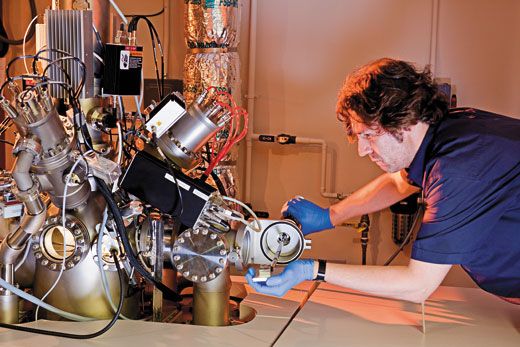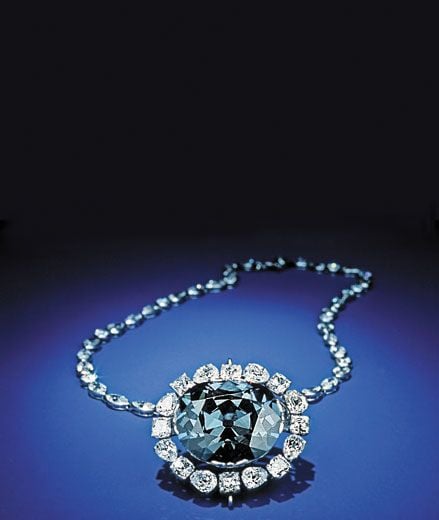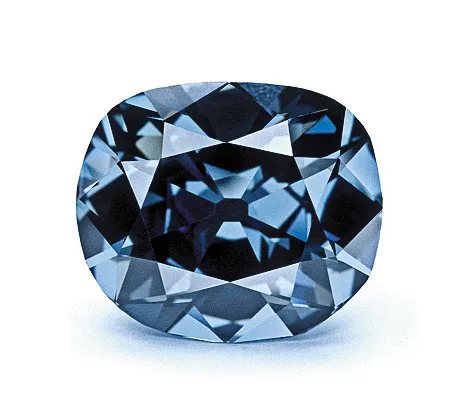Testing the Hope Diamond
Scientists at the Natural History Museum search for the elusive “recipe” that endows the famed gem with its unique blue color
/https://tf-cmsv2-smithsonianmag-media.s3.amazonaws.com/filer/ATM-Night-at-the-Museum-631.jpg)
At first, Evalyn Walsh McLean, an heiress living in Washington, D.C., didn’t want to buy the Hope Diamond. She was unhappy with the setting surrounding the precious blue stone that had once belonged to King Louis XIV and asked jeweler Pierre Cartier to create a new one: a circle of 16 clear diamonds, shaped like squares and pears.
That was in 1910, and for much of the past century the Hope Diamond remained in its Cartier setting. But several months ago, it was taken from the National Museum of Natural History’s gem hall for an overnight stay in the mineralogy lab. There, geologists conducted an experiment to learn precisely why the Hope Diamond is so blue. Every gem has its own unique molecular formula, which is determined by how its atoms bond together in the extreme heat of the planet’s crust. But the formula for deep ocean blue is rare, occurring in only one out of every several hundred thousand diamonds. At 45.52 carats, the Hope, discovered in 17th-century India, is the largest-known deep blue diamond. “Its creation, as far as we know, is a completely unique event in the history of the earth,” says geologist Jeffrey Post, a curator at Natural History.
But before the experiment could begin, some delicate surgery had to be performed to remove the blue diamond from its setting. At 9:16 p.m in a room almost as long as a bus, where fluorescent lights and white walls canceled out even the sparkle of topaz on the shelves, jeweler Stephen Clarke donned a pair of glasses equipped with magnifying lenses and reached for his tools. He steadied the walnut-size gem in his left hand—his fingerprints smearing its 60 facets—while his right hand wielded a pair of tweezers. “It’s like a little puzzle,” Clark said, as he unhooked the small wire rivets holding the diamond in place.
A security officer peeked into the room. “Look at that,” he said. “It’s even more beautiful out of the setting than in.”
At 12:35 a.m., two researchers wearing blue gloves cleaned the stone of the jeweler’s prints. Carefully, they loaded it into a custom-made mount and placed it into the chamber of a device that would fire an ion beam, boring a ten-angstrom-deep hole (just over four-billionths of an inch) into the gem.
“Looks more like a science experiment than a fancy gemstone right now, doesn’t it?” Post said to a film crew from the Smithsonian Channel, which will air a documentary on the Hope Diamond on November 21.
It would be another hour before the experiment could begin, since all the air first had to be pumped out of the chamber to create a vacuum. The scientists rested their eyes. “This is our one shot,” Post said. “We’ll take measurements until they tell us the diamond has to be put back on display.”
While the precise recipe for the Hope is a mystery, geologists know that the primary ingredient endowing the diamond with its color is the element boron. The night’s research may someday be applied to making synthetic blue diamonds—not only for jewelry, but for electronics. Boron allows current to pass through the stones more efficiently than your average semiconductor. “It’s not clear yet how we’re going to be able to make these things,” Post said, “but the experiment gives us a way of seeing how nature did it.”
At 2:35 a.m., with the click of a computer mouse, the ion beam fired. Millions of Hope Diamond atoms sputtered into the vacuum. They were sucked into a tube, past a detector that analyzed the elements.
The initial results came in. Colored spikes appeared on a computer screen, announcing the presence of boron, carbon, hydrogen and possibly some nitrogen. Based on the findings so far, the concentration of boron varies within the diamond, ranging from zero to eight parts per million. The Hope is actually a mosaic of blues.
It will be months before the scientists publish the full results of their experiment. In the meantime, the Hope is back in its display case and—unknown to most museum visitors—a few million atoms lighter.
/https://tf-cmsv2-smithsonianmag-media.s3.amazonaws.com/accounts/headshot/joseph-caputo-240.jpg)



/https://tf-cmsv2-smithsonianmag-media.s3.amazonaws.com/accounts/headshot/joseph-caputo-240.jpg)